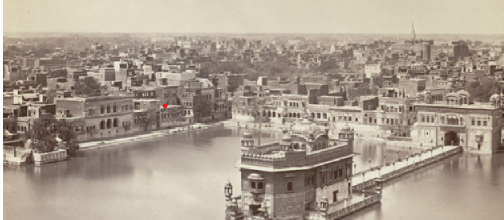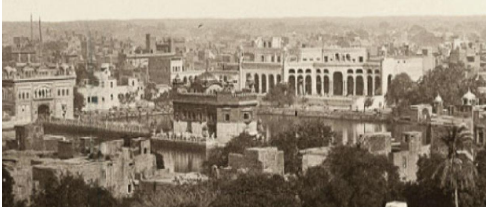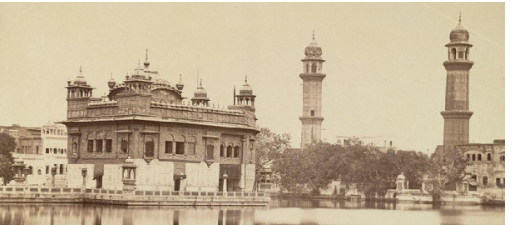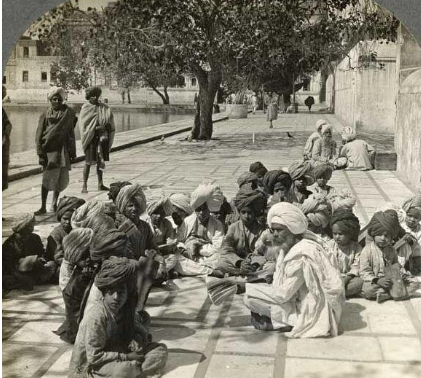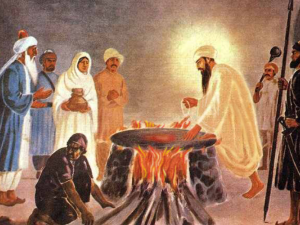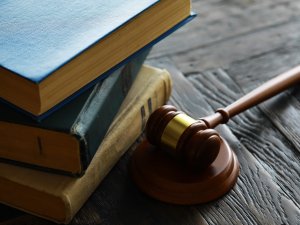The word Bunga is derived from Persian language. Bunga in Persian means the place to rest , a rest house or a place of dwelling. In Sikhism we can say Yatri Niwas or a rest house for pilgrims. The building made for this purpose is called Bunga.
According to Rattan singh Bhangu these buildings or Bungas were erected during the Guru period when the work of Srover (Holy Tank) was going on.
Dr. Madanjit Kaur says these were only hutments made near Srover, but these were not called Bungas.
According to other historians, they believe that when invaders from Afghanistan started attacking Hindustan, they had to pass through Punjab. In Punjab the brave Sikhs put up a strong resistance. No doubt the target of Invaders like Nader Shah and Abdali, was to conquer Lahore and Delhi, but the Sikhs created alot of trouble for them. As many Sikhs as they killed, they increased. This compelled the invaders to find the cause. The invaders came to know that at Amritsar, Sikhs have a supreme historical place of worship, they call it Sri Harimandir sahib. There is a pool of nectar, Sikhs used to have a dip in it and they become more stronger. This pool ( Srover ) has some special powers. This deviated the attention of Mughal and Afghan invaders to destroy the Sikhs and their Harimandir sahib.
Several times the Srover was desecrated, and Harimander was damaged. Each time Sikhs repaired it, but in 1762 Ahmed Shah Abdali attacked and blew up the Harimandir with Gun powder and desecrated the srover by filling it with cow blood, cow bones and cow flesh. After this destruction when Abdali left for Afghanistan, Sikhs then again assembled at Sri Darbar sahib and a discussion was made for the security of Sri Harmandir sahib. It was decided to construct a row of houses (Bungas) around the parikarma of srover. All the sikh sardars who can afford should come forward for this task. S. Jassa Singh Ahluwalia, S. Jassa D Ramgarhia , S. Kanahiya and Bhangi Sardars came forward and took the duty to encourage others for these Bungas. These Bungas can serve dual purpose , one to give accommodation to the pilgrims and second to provide security to Sri Harmandir Sahib. The person who was in charge for each bunga as manager was called (Bungai). Along with Bungai some soldiers can also stay in side bungas for security purpose. History says most of Bungas came into existence in the eighteenth century.
Giani Gian Singh ji says that first of all the first Bungas started at the western side of srover, opposite Darshani deodhi named Akal Bunga in Bikrami 1663 (1606 A.D.). The sixth Guru Sri Guru Hargobind ji founded this and made a Plinth ( small platform) where fourth Guru Sri Guru Ramdas ji used to sit under a Ber Tree and observe the progress of the work. This bunga was completed later for the cost of Rs. 2,73,000/-.(Two lac seventy three thousands). There were 69 bungas, on four sides of Parikarma of srover. West side = 28 Bungas, North side = 9 Bungas, East side = 10 Bungas and south side = 22 Bungas. Total 69.
Bungas arround prikarma sri darbar sahib, according to Giani Gian singh ji ( Tawrikh sri Amritsar )
Bungas on the West side.
- Bunga Jalliyan wala 3 stories Samat 1830. 11000/-
- Bunga Shah Badian 3 stories “ 1830 8000/-
- Bunga Majithian 3 stories “ 1870 11000/-
- Bunga Singh purian 2 stories “ 1860 5000/-
- Bunga singh purian 2 stories “ 1865 4000/-
- Bunga Gadowalian 1 story “ 1850 4500/-
- Bunga Khushal singh 3 stories “ 1871 9340/-
- Bunga Ghanaya 3 stories “ 1809 9000/-
- Bunga Raja Dhyan singh 3 stories “ 1881 6547/-
- Bunga Barandari 2 stories “ 1827 4000/-
- Akal Bunga 3 stories “ 1663 2,73,400/-
- Bunga Jodh singh Chhapa wala 1 story 1850 2500/-
- Bunga Dewa singh Shaheed 2 stories 1822
- Bunga Bhag singh 2 stories 1822
- Bunga ragi Dhanpat singh 2 stories 1830 700/-
- Bunga Gen. Mihan singh 4 stories 1871 9000/-
- Bunga Giani Gurdas ji 2 stories 1861 1250/-
- Bunga Abhey singh 2 stories 1858 700/-
- Bunga Nakai sardars 2 stories 1847 3000/-
- Bunga Barki sardars 2 stories 1836 5000/-
- Bunga Ghadialian 3 stories 1841 4900/-
- Jhanda bunga 3 stories 1840 6000/-
- Bunga Chumari Sardaran 2 stories 1841 5000/-
- Bunga Gadwaian 2 stories 1837 2500/-
- Bunga Siyalkotian 2 stories 1848 2000/-
- Bunga Gond walian 1 story 1850 2500/-
- Bunga Chichi Sardaran 2 stories 1850 1200/-
- Bunga Shukarchakiya 3 stories 1840 18000/-
Bungas on the North side
- Bunga Ladwe Wala
- Bunga Kunwar NouNihal
- Bunga Rani sada kaur ( Haveli )
- Bunga Dadu Puria Sardars
- Bunga Sant Nirmala
- Bunga Maharaja Sher Singh
( All these six bungas were demolished in 1850 a Police chownki was established. In 1863 the police chownki was again demolished and a clock tower was constructed which completed in 12 years of span and costed 1,75,000/- Rs. )
2. Bunga Sodian of Anandpur 2 stories 1850 12000/-
3. Bunga Sant kahan singh 3 stories 1882 3000/-
4. Bunga Kahan singh Ragi 1864 3000/-
5. Bunga NurMahalya 2 stories 1870 2200/-
6. Bunga Ahluwalia 3 stories 1860 26000/-
7. Bunga Malwaiyan 4 stories 1835 50000/-
8. Bunga Bhai kiyan Kaithal 1844 5000/-
9. Bunga Jalehwaliyan 5 stories 1860 28000/-
( Giani Gian singh ji has counted bunga from 1 to 6 as one, if we count all these bungas in serial nos . then it makes 14 and the total of 74 bungas comes true instead of 69.)
Bungas on the East side
- Bunga Akhada Mahant Santokhdas 6 stories 1812 1,50,000/-
- Bunga Goiani ram singh 1835 1800/-
- Bunga Jassa singh Ramgarhia ( Biggest ) 1812 2,75,000/-
- Bunga Budiyewala 2 stories 1828 3000/-
- Bunga Jethuwalia 2 stories 1835 2000/-
- Bunga Majhbi singhan 2 stories 1839 5000/-
- Bunga Bhai Basti ram 3 stories 1870 25000/-
- Bunga Jwala singh Bdhana 3 stories 1865 18000/-
- Bunga Mahant 3 stories 1807 30000/-
- Bunga Tek singh 2 stories 1860 1800/-
Bungas on the South side
- Bunga Solanwala 1842 3000/-
- Bunga Budh singh 1 story 1847 1500/-
- Bunga Suyian wala 2 stories 1863 2000/-
- Bunga Shaheedan wala 2 stories 1821
- Bunga Kesgarhia 2 stories 1822 2800/-
- Bunga Anandpur Sodhian 2 stories 1850 2500/-
- Bunga Dasoudha singh 1 story 1824 3000/-
- Bunga Sujaleh wala 2 stories 1845 2300/-
- Bunga Kaliyan wala 1 story 1852 2000/-
- Bunga Tara singh Gaiba 2 stories 1822 2000/-
- Bunga Tara singh Maan 2 stories 1821 4700/-
- Bunga Thanesrian 2 stories 1823 2500/-
- Bunga Teja singh Sahnewal 2 stories 1819 2800/-
- Bunga Shaloudi wala 3 stories 1821 2200/-
- Bunga Miran Kotia 1 story 1841 2900/-
- Bunga Sham singh Atari 2 stories 1855 6000/-
- Bunga Jassa singh Nirmala 3 stories 1821 2500/-
- Bunga Lakha singh 3 stories 1841 3000/-
- Bunga Chadat singh Ragi 3 stories 1850 2600/-
- Bunga Jodh singh sedia 2 stories 1821 5000/-
- Bunga Bhadaniyan 2 stories 1867 2700/-
- Bunga Kholawal 1 story 1831 4200/-
( So this totals 10+14+28+22= 74 Bungas . There were 13 entries to enter parikarma of Darbar sahib. At that time the 1000 brick costs only 10 Annas. All dates are Vikrami Samat.)
Giani Gian singh ji also tells us that one earlier Bunga was made by Majhbi Sikhs on the east side of srover , a single story costing Rs. 5000/- in Bikrmi 1634 ( 1577 AD). But on other hand S. Karam Singh, the historian says it was a two-story and built in Bikrmi 1839 (1782 AD). The difference in dates needs another research.
S. Karam singh Historian writes that the total number of bungas were 74. According to him Bungas on the west side totalled 28, Bungas on North sode of srover ,14, Bungas on East side,10 and Bungas on South side ,22. This way it makes a total of 74 Bungas.
Dr. Madan jit Kaur Gives the detail, according to old historical manuscripts the counting of total Bungas were 84. But we get the proper account of 74 only.
Barron Charls Hughal (1844) writes during his journey in the Punjab, he visited Sri Harmandir Sahib. He says that the Sarover (Holy Tank) was surrounded with considerably good houses. Each house had windows which were able to open towards Harimandir sahib and one could catch a glance of Darbar sahib. Most of the houses have stairs opening in Parikarma. All the entries to Darbar sahib were secured with gates.
Territory Gezett of east India company (1854) It is mentioned in this gazette that Amritsar city is a walled city, the streets are narrow but the buildings are made of kiln ( Pucca) bricks. The city is famous for a Holy place of Sikhs called Harimandir and its Srover ( holy Tank ). The water of Srover is crystal clear, and the priests and other Akali sardars have made their houses around the Srover.
Old Bungas in Parikarma. Source Wikipedia.
Lost palace of Maharala Sher Singh in Parikarma. Source Sikhmuseum.com
Giani Gian singh ji tells us about the earlier Bungas made around srover, which were three and others was came into existence later. Firstly Kanhya Sardars made their Bunga on Western side of srover in Bikrmi 1809 (1752 AD) which was three storys. Another two Bungas were constructed on Eastern side in Bikrmi 1812 ( 1755 AD ) . One was Bunga Akhara Santokh Dass which was six (6) story and costed Rs. 31,500/- . second was Bunga S. Jassa singh Ramgarhia, which was 4 story and costed Rs. 2,75,000/-. But Giani ji tells us this Bunga is two story only. He did not clear that he is talking two upper stories or the two lower basements. This Bunga has one story at ground floor and other three stories are at under ground basements.
Karam singh Historian accepts that this Ramgarhia Bunga is biggest among all the bungas and it has two watch towers ( minarets ) .
For the time being it is important to mention that it was the farsight of S . Jassa Singh Ramgarhia , that for security it is necessary to keep an eye on the enemy or invaders. For that it is important to watch them from height, and this can be done only if one standing on higher place. The result was these high watch towers. One drummer was deputed on one tower 24 hrs. to keep an eye on enemy. As soon as he sees some thing abnormal he beats the drum and this was a signal for Khalsa to become alert.
Some people thinks that these watch towers are the Bungas. But they are mistaken, Minarets are only to keep an eye on surrounding from height. Bunga Ramgarhia is the only Bunga which has two minarets. Watch tower (Minaret) made at Darbar Sahib Sri Tarn Taran sahib also made by S. Jassa Singh Ramgarhia only for this security reason. The Bunga ( guest house) made later on by Sikhs.
Harimandir and Bunga Ramgarhia 1880 . Source Sikhwiki.
Maximum Bungas came to existence after 1755 AD. These Bungas were not only serving the purpose of security to Sri Darbar Sahib and dwelling place for pilgrims but also contributed a place for development in the field of social, educational, music, literature and art . Like Akal Bunga ( Akal Takhat) holds an eminent place in sikh community. It is a supreme administrative seat of Sikhism. All the major Gurmatas, Hukamnamas etc. on the name of Sikh sangat are issued from here. In the Misl era the whole decisions about the trading , religious, political and administration of Misls were taken by Akal Bunga.
These Bungas can be divided in few catagories.
Misl Bungas :- belongs to different Misls.
Personal Bungas :- Bunga belongs to various chiefs or sardars.
Community Bungas :- Bunga belongs to prominent communities.
Religious Bungas :- Bungas belongs to various religious sect like Nirmalas, Sewa Panthies and Udasies etc.
Bungas belongs to the people doing different services.
Now when we talk contribution of Bungas in other fields, it can be described as following.
Sant Nihal singh ji belong to Bunga Solhnwala, was a great poet. He wrote Kavendra Parkash Granth in this Bunga.
Bunga Ahluwalia was famous far Kirtan, The respected mother of S. Jassa Singh Ahluwalia was well known for Kirtan and she used to do it daily in this Bunga. It seems S Jassa Singh also learned kirtan from his mother.
Bhai Sant singh, who lived in Bunga Granthian, was a great scholar and he wrote a good book on Amrit.
S Gurmakh singh Granthi of Akal Bunga was also a great poet and he compiled Guru Bilas Patshahi Chhevi.
Bhai Budh Singh who lived in bunga Shaheedan was a great translator and working in the court of Maharaja Ranjit Singh. He translated many Persian manuscripts in Hindi, for Maharaja.
S. Rattan Singh Bhangu who was residing in Bunga Sham Singh (Bunga Singh Puria) and completed his famous book Prachin Panth Parkash in 1841 Ad. Here.
Bhai Santokh Singh Chudamani has completed his famous Granth Suraj Parkash while staying in Bunga Gianian.
Bunga Udasi and Nirmalas were educational centers famous for teaching Sanskrit and Gurmakhi languages.
Old Pathshala in Parikarma. Source Sikhmuseum.com
Some Bungas were famous for teaching musical instruments, Ragas, Kirtan etc.
Bunga Jalianwala was famous for the treatment of skin disease.
V.N.Datta writes that Harimandir Sahib was surrounded with many Bungas and most of them have Paintings of Kangra art. This Kangra style art in paintings was very famous in those days.
Some artists used to stay in these Bungas and did their paintings.
The heritage that we used to have is so beautiful and valuTghe able but all was destroyed one by one on the name of beautification and widening of Prikarma.
What is left only at last are two Bungas, one Akal Bunga and the Bunga Ramgarhia.



